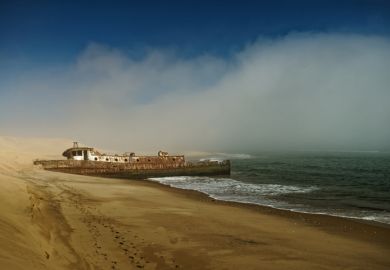Most works on environmental economics operate in a mythical world of saintly politicians, 20/20 foresight and laws of economics that are hard to reconcile with the real world. Stephen Merrett, a consultant in environmental economics with a splendid disdain for the need to butter up future clients, brings the real back into the world of water economics with breathtaking clarity.
His Introduction to the Economics of Water Resources comes out at a propitious moment. Water is a hot issue. Global limits on water supply appear to be closing in. The number of countries predicting water shortages within the next few decades grows ever longer. Access to water is a key issue in several international disputes, notably in the Middle East, not to mention myriad local disputes worldwide.
Meanwhile, the World Bank, which has financed more large dams and other water projects than any other agency in the past half-century, is getting cold feet in the face of cost over-runs, engineering and economic underachievement and the political backlash from environmentalists and from people threatened with the loss of their land beneath large reservoirs. Just last month, the bank announced the appointment of a South African cabinet minister, Kader Asmal, to head a World Commission to review the social, environmental and economic impact of large dams.
Merrett's lucid, up-to-date, sometimes caustic and always stimulating international review would be a good read for Asmal's commission. Its scope is wide. He is as at home in what he calls the "hydrosocial cycle" as in the hydrological cycle. And he taps the full range of the hydrological cycle as redrawn by humans. Here are land drainage, the eutrophication of lakes, waste-water treatment, big-dam engineering, domestic water use, coastal defences and much more.
There are case studies ranging from saline flooding in Norfolk to dams on the Danube, water rates in Latvia to privatisation in Peru; protecting bird habitats in Britain to bailing out farmers in California. Fans of The Guardian's old April Fool joke, the typographical island state of Sans Serif, will be pleased to see its return here as the setting for the analysis of a basket-case water supply organisation being primed for privatisation.
Water, as Merrett points out, is a common, universally needed resource, a "gift of nature". But unlike the air or sunlight, water can be appropriated into ownership. It is therefore also an economic resource. This status has grown in importance in recent years as water shortages have increased, as many public water utilities have been privatised, as pollution controls have raised the costs of the disposal of used water, and as the pressure has grown from aid agencies and the World Bank for the economic pricing of water, in the interests of efficient use.
But, far from being dominated by conventional economics, Merrett's analysis is also deeply imbued with the lessons learnt by environmental and social campaigners in opposing some of the more absurd water engineering projects of the past generation. And he is politically very savvy - not least in his analysis of the Pergau dam saga, in which he sees a British government in pursuit of an arms deal with Malaysia over-ruling official economic and environmental advice by pushing ahead with overseas aid for a hydroelectric dam there.
Merrett is at pains to upturn apple carts. Many people think "water wars" are inevitable in the arid Middle East as water crises become linked to more conventional sources of tension. But it ain't necessarily so. Merrett valuably introduces the concept of "virtual water", as developed by the Middle East water specialist Tony Allan of the School of Oriental and African Studies in London. He points out that for the past 25 years, Middle East governments have staved off crisis by importing "virtual" water in huge quantities in the form of food. His prognosis is optimistic.
Merrett is especially hard on economic nostrums that divert analysts from addressing the real world. It is too easy to try to bludgeon reality until it fits a convenient economic model. Thus he backs the view that neoclassical economics is "a methodology which sanctifies fictions and diverts attention from the difficult task of analysing real world phenomena". And nowhere more so than when it is dealing with an economic/environmental resource such as water, whose supply is a "natural monopoly".
Later he takes splendid issue with one of the most fashionable tools of environmental economics, "contingent valuation". Put crudely, this involves lots of people with clipboards asking lots of other people how much they would be prepared, as individuals, to pay for a clean river, smog-free air or elephants in a safari park. The idea is to get round the difficulty of establishing a market price for environmental "goods". The end product might, for instance, be to weigh the "contingent valuation" of animal habitat lost to a reservoir, or of clean air in Kuala Lumpur sacrificed to the agricultural profits yielded by burning the rainforests of Sumatra. The problem is that people do not see the environment as something they can own or pay for individually. It is a common good, with much of its value coming from being shared. And they become angry if and when they discover that their answers to the questionnaires are being used to frame environmental policy.
Merrett will have none of this bogus economics. "The concept of a market price, in the real world, denotes money changing hands. The concept of contingent valuation, again in the real world, denotes a response to a questionnaire," he writes. "It makes as much sense to subtract the contingent value of the reduced population of Sumatran rhinoceroses from the output value of a hydroelectric dam as it does to subtract three buttercups from five watts."
This is a book for economists anxious to grapple with the real world - but also for environmentalists, water engineers and policy-makers keen not to be hoodwinked by economists. Its references and case studies almost all come from the 1990s. Its prose is a model of clarity. It is a cracking, mould-breaking read.
Fred Pearce is the author of The Dammed.
Introduction to the Economics of Water Resources
Author - Stephen Merrett
ISBN - 1 85728 637 5
Publisher - UCL Press
Price - £14.95
Pages - 211



